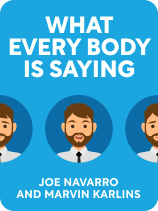

This article is an excerpt from the Shortform book guide to "What Every Body Is Saying" by Joe Navarro and Marvin Karlins. Shortform has the world's best summaries and analyses of books you should be reading.
Like this article? Sign up for a free trial here.
How can you tell a person is lying? Can you know with certainty someone is being untruthful?
According to former FBI agent Joe Navarro, there’s no definitive behavioral response that indicates someone is lying. However, as a general rule of thumb, someone who is lying will display insecure behaviors because deception takes mental effort and causes stress.
With this in mind, here are some tips on how to detect a lie.
Tips for Detecting Deception
No behavioral cue can directly indicate whether or not a person is lying. Research has shown that even the most experienced behavioral analysis experts have, at best, a 60% chance of correctly guessing whether someone’s lying. For this reason, Navarro cautions you to be careful when using body language alone to accuse someone of deception. Further, he offers some tips on how to detect a lie, drawing from his experience as an FBI agent.
Tip #1: Get a Complete View of the Person
Navarro suggests you clear any obstacles between you and the person you’re interacting with so that you can observe their full body. He states that oftentimes the most honest half is concealed under a table, making it harder to make good judgments.
(Shortform note: When you think of a police interrogation room, you might imagine a room with two chairs and a table in between them. In recent years, experts are becoming more aware of the importance of nonverbal cues and argue for the removal of physical barriers between interviewer and interviewee. They elaborate that this type of barrier not only physically hinders your ability to read their body language cues but serves as a psychological obstacle to building rapport. Instead, they suggest the interviewer and interviewee sit less than four feet apart.)
Tip #2: Make the Person Feel Comfortable
Since discomfort can indicate deception, try to help the person feel comfortable at the start of your interaction. This gives you a baseline to judge their future behaviors when you transition into more difficult topics.
(Shortform note: While Navarro doesn’t provide any advice on how to make your interviewee more comfortable, experts provide some actionable suggestions: maintain eye contact and match their body language. Therapists, for instance, often mirror the body language of their patients to subtly convey understanding and cultivate a feeling of comfort.)
Tip #3: Ask Focused Questions
Navarro explains that just because someone’s talking a lot doesn’t mean that they’re telling the truth. By controlling the conversation with specific questions, you can trigger behavioral cues in someone instead of letting them ramble and lead the interaction.
(Shortform note: To lead an interaction with focused questions, consider asking a series of “funnel questions,” which start off broad and grow more specific or vice-versa. Useful in a variety of situations, such as job interviews, funnel questions allow you to get detailed answers and easily change the focus of the conversation according to your needs.)
Tip #4: Look for Self-Comforting Behavior
After asking a focused question, assess the person’s stress levels by looking for any attempts they make to comfort themselves. When you observe self-comforting behaviors, try to make note of what stimuli preceded it to get an understanding of what made them uncomfortable.
(Shortform note: According to psychologist Paul Gilbert, these self-comforting behaviors often follow a distressing question because our bodies have a natural soothing system, much like our threat response system that Navarro focuses on. Like the limbic system, this soothing system is hardwired into our bodies, and it relieves the intense effects of the stress response.)
Tip #5: Leave Room for Silence
Navarro advises you to insert deliberate pauses between your questions so that your interviewee has time to react and you have time to observe. Instead of drilling them with a series of questions, ask a single question and wait for a response.
(Shortform note: Leaving space for silence in your interactions is useful beyond trying to detect deception. In The Coaching Habit, Michael Bungay Stanier writes that being comfortable with silence is also a good practice for coaching and understanding others. He writes that asking too many questions back-to-back can be overwhelming, and giving people space allows for thoughtful responses.)

———End of Preview———
Like what you just read? Read the rest of the world's best book summary and analysis of Joe Navarro and Marvin Karlins's "What Every Body Is Saying" at Shortform.
Here's what you'll find in our full What Every Body Is Saying summary:
- A guide from a former FBI agent on how to decipher body language
- How to master the language of nonverbal communication
- How to detect when someone is lying to you and access their true thoughts






